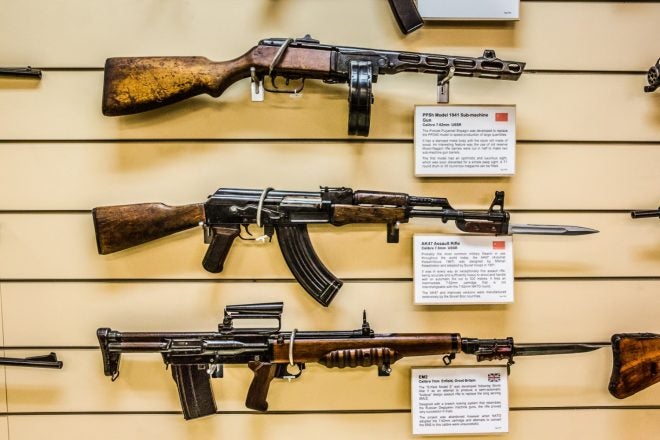The firearms and museums communities were recently made aware of an online petition started by the Lithgow Small Arms Factory Museum aimed at saving the firearms (and the history) in their collection.
Apparently, the government in New South Wales (that’s in Australia, for the geographically challenged among us) changed the requirements for firearms displayed in museum exhibits and kept in collection storage. Prior to 2017, museums only had to remove firing pins to create “temporary deactivation,” thereby making the guns legal to own/display/collect.

Entrance to the LSAF Museum (Courtesy Brendan Maunder)
The new regulation was passed in November 2017, but it seems to have flown under the radar until very, very recently. This new regulation goes beyond “temporary deactivation” and would require that the firearms be made “permanently inoperable.”
According to the Lithgow Small Arms Factory Museum and their petition, the process of making the firearms legal now “involves inserting a steel rod down the barrel of the firearm and welding the muzzle and chamber, welding the barrel to the receiver, removing the firing pin and welding the hole, removing all internal springs, welding internal components and welding the bolt, magazine, external hammer and trigger in a fixed position.”

Rows and rows of rifles (Courtesy Brendan Maunder)
The petition goes on to state that by doing this, “the firearm will be reduced to a metal blob rather than a genuine firearm.” A sad and painfully accurate assessment of the situation.
The LSAF Museum is located in the old firearms factory in Lithgow, as the name states. The museum opened in 1996 and is staffed entirely by volunteers. The collection includes such items as “Serial No. 1 Guns” produced at the factory, including L1A1 SLR (serial no. AD5900001); F88 Austeyr (serial no. SAF8800001); F1 carbine (serial no. AD6400001); and sectionized F89 Minimi light support weapon (serial no. SW950001).
Their collection also includes experimental and prototype arms that never made it to full production, including the No 6 Mk 1 and the No 6 Mk 1/1 carbines, which were never adopted by the Australian Army.

Cutaways made at LSAF are part of the collection.
With the strict anti-gun laws in Australia, the LSAF Museum is also home to a variety of other arms that Australians will likely never see outside of the galleries. (Well, the only way they’ll see them legally.) Some examples include Dardick revolvers, Liberator pistols, and the SW500 Magnum revolver.
Aside from firearms, the museum also has displays on the factory’s history and its workers. Of course, the factory and the workers wouldn’t be part of history if not for the firearms made there, so the bread-and-butter of the collection IS the firearms. With this new regulation, the museum’s ability to accurately and adequately fulfill its mission is irreversibly compromised.

All slated to be turned into “metal blobs.”
The petition accurately states what will happen if they are forced to destroy 70% of their collection: “We will lose significant value, considerable patronage and become non-viable. And with this, there will be an unimaginable loss of history, knowledge and community-based volunteering spirit.”
Regulating museum firearms the way they regulate all other firearms is a mistake. Museums deserve to be treated differently to other firearm stakeholders in that we preserve, commemorate and showcase historical and educational value for the benefit of the wider community and future generations.
A total of 10,000 signatures are needed for the petition to be delivered to the New South Wales Police Minister. Currently, there are just over 3,100. Learn more about the petition by clicking here.
 Your Privacy Choices
Your Privacy Choices
